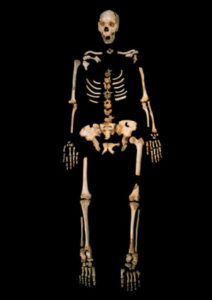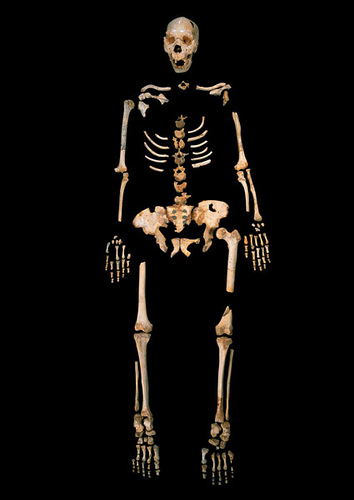
Researchers at the Max Planck Institute for Evolutionary Anthropology in Leipzig, Germany, have successfully sequenced a complete mitochondrial (mtDNA) genome of a 400,000-year-old representative of the genus Homo from Sima de los Huesos, a cave site in northern Spain that has yielded some of the earliest fossil specimens of humans in present-day Europe. They found that the ancient individual was related to Denisovans, extinct relatives of Neanderthals in Asia, through a common ancestor.
“The fact that the mtDNA of the Sima de los Huesos hominin shares a common ancestor with Denisovan rather than Neanderthal mtDNAs is unexpected since its skeletal remains carry Neanderthal-derived features”, says lead researcher Matthias Meyer. Considering their age and Neanderthal-like features, the Sima hominins were likely related to the population ancestral to both Neanderthals and Denisovans. It is estimated that the ancestral population existed about 700,000 years ago. Another possibility is that gene flow from yet another group of hominins brought the Denisova-like mtDNA into the Sima hominins or their ancestors.
Sima de los Huesos, otherwise known as the “bone pit”, has yielded the world’s largest assembly of Middle Pleistocene (ca. 781 to 126 thousand years ago) hominin fossils, a total thus far of at least 28 skeletons, excavated and pieced together over the course of more than two decades by a Spanish team of paleontologists led by Juan-Luis Arsuaga. The fossils are classified as Homo heidelbergensis, but also carry traits typical of Neanderthals.
______________________________________________________________________________________________________________________
Skeleton of a Homo heidelbergensis from Sima de los Huesos. Credit: Javier Trueba, Madrid Scientific Films
_______________________________________________________________________________________________________________________
Artist’s reconstruction of Homo heidelbergensis using forensic techniques. Cicero Moraes, Wikimedia Commons
_____________________________________________________________________________________________________________________
Meyer and his team have developed new techniques for retrieving and sequencing highly degraded ancient DNA, the kind of DNA that would be expected from fossils as old as the one sampled from the cave. In cooperation with Juan-Luis Arsuaga, director of Spain’s Center for Research on Human Evolution and Behaviour, Meyer and his team first applied the new techniques to a cave bear from the Sima de los Huesos site. Following this success, the researchers sampled two grams of bone powder from a hominin thigh bone from the cave. They extracted its DNA and sequenced the genome of the mtDNA, a portion of the genome that is passed down along the maternal line. The researchers then compared this ancient mitochondrial DNA with Neanderthals, Denisovans, present-day humans, and apes.
Until now, it has not been possible to study the DNA of hominins that are dated to the Middle Pleistocene, or older, except DNA extracted from specimens in the permafrost.
“Our results show that we can now study DNA from human ancestors that are hundreds of thousands of years old. This opens prospects to study the genes of the ancestors of Neanderthals and Denisovans. It is tremendously exciting” says Svante Pääbo, director at the Max Planck Institute for Evolutionary Anthropology.
“This unexpected result points to a complex pattern of evolution in the origin of Neanderthals and modern humans. I hope that more research will help clarify the genetic relationships of the hominins from Sima de los Huesos to Neanderthals and Denisovans” says Arsuaga.
The next step for the researchers: retrieving and sequencing mtDNA from more individuals excavated at the Sima site, including nuclear DNA (DNA that contains information inherited from both parents and represents more of the genome).
The details of the study have been published in the December 4, 2013 issue of the journal Nature.*
_________________________________
Source: Adapted and edited from a press release of the Max Planck Institute for Evolutionary Anthropology in Leipzig, Germany
* Matthias Meyer, Qiaomei Fu, Ayinuer Aximu-Petri, Isabelle Glocke, Birgit Nickel, Juan-Luis Arsuaga, Ignacio Martínez, Ana Gracia, José María Bermúdez de Castro, Eudald Carbonell and Svante Pääbo, A mitochondrial genome sequence of a hominin from Sima de los Huesos, Nature, 4 December 2013 (DOI: 10.1038/nature12788)
_______________________________________________________________________________________________________________________
Read about the most fascinating discoveries with a premium subscription to Popular Archaeology Magazine. Find out what Popular Archaeology Magazine is all about, including the special Holiday Discount offer. AND MORE:
 Popular Archaeology’s annual Discovery edition is a selection of the best stories published in Popular Archaeology Magazine in past issues, with an emphasis on some of the most significant, groundbreaking, or fascinating discoveries in the fields of archaeology and paleoanthropology and related fields. At least some of the articles have been updated or revised specifically for the Discovery edition. We can confidently say that there is no other single issue of an archaeology-related magazine, paper print or online, that contains as much major feature article content as this one. The latest issue, volume 2, has just been released. Go to the Discovery edition page for more information.
Popular Archaeology’s annual Discovery edition is a selection of the best stories published in Popular Archaeology Magazine in past issues, with an emphasis on some of the most significant, groundbreaking, or fascinating discoveries in the fields of archaeology and paleoanthropology and related fields. At least some of the articles have been updated or revised specifically for the Discovery edition. We can confidently say that there is no other single issue of an archaeology-related magazine, paper print or online, that contains as much major feature article content as this one. The latest issue, volume 2, has just been released. Go to the Discovery edition page for more information.
Subscription Price: A very affordable $5.75 for those who are not already premium subscribers of Popular Archaeology Magazine (It is FREE for premium subscribers to Popular Archaeology). Premium subscribers should email [email protected] and request the special coupon code. Or, for the e-Book version, it can be purchased for only $3.99 at Amazon.com.







